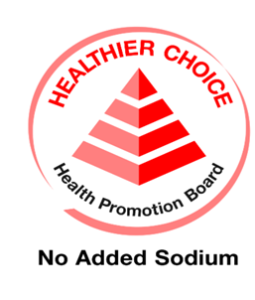Eating habits are a form of culture that has the primary effect on the health profile of each country around the world. While some countries are struggling with constantly increasing rates of obesity and cardiovascular diseases due to excessive consumption of sugar and fat, others considered as healthy, however, are worrying about nutrient deficiency.
For this reason, governments are constantly brainstorming to come up with the clearest ‘map’ for consumers to guide them through their daily choices of food products. By ‘map’ here, we are talking about the nutrition facts and all related claims displayed on food products.
In this article, we will walk you through the latest updates in regards to the nutrition facts labeling and related claims.
1. Updates on Nutrition Facts Labelling (Canada)
Given the challenges raised by the COVID-19 crisis, the Canadian government has extended the transition period from December 14th, 2021 to 2022 instead, for food producers to comply with the new requirements for the nutrition facts and ingredient list.
These amendments are intended for a better understanding for consumers of the contents of the products and are as follows:
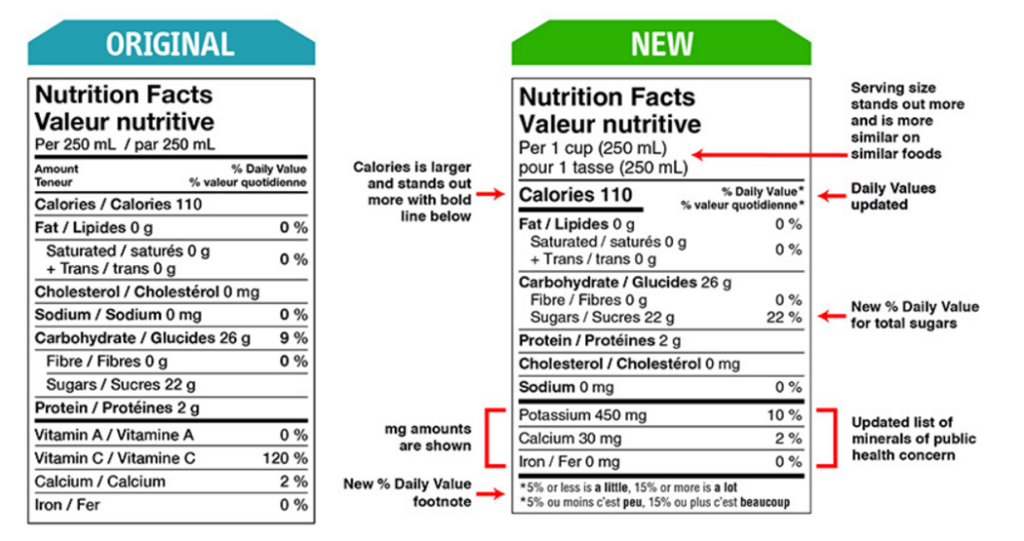
Now compared to the new nutrition facts table for the U.S, attention is given to the serving size and its calories, as it will help consumers make a more realistic choice while comparing to other similar food products. Potassium has also been added for its importance to the Canadians’ diet, while vitamin A and vitamin C were removed as Canadians’ diet is already rich enough.
*There are regulations regarding the standard amount of serving size in Canada
Under Food Labeling Standards in Japan, minerals (e.g., potassium, calcium, iron, etc.) and vitamins (e.g., vitamins A, C, B1, etc.), etc. are listed as nutrient components in Appended Table 9 of Food Labeling Standards, and can be labeled voluntarily. Sugars are also nutrients for voluntary labeling (however, if these nutrients are labeled on the container or packaging, or if a nutrient content claim is made for specified nutrients, it is mandatory labeling). Sodium is converted to “salt equivalent” and displayed.
2. Ingredients list labeling updates (Canada)
The Canadian government has also announced changes to the ingredient list, with particularly significant changes to the labeling of sugars (the definition of sugars is provided separately). Sugars can now be grouped in brackets and in descending order of weight, following the word ‘sugars’, which will help consumers easily spot all sources of sugars present in the food product. The above is only required when the final product contains 0.5 g or more of sugars/serving.
In Japan, however, sugars do not need to be grouped and labeled unless individual labeling methods are stipulated, such as for foods specified in Appended Table 4 of Food Labeling Standards.
On an additional note, if you wish to use claims for sugars on your products marketed in Canada, you need to review the information provided in the summary table, which outlines the terms and phrases that may be used and the conditions required, etc. Please note that claims such as “low carbohydrate”, and “light” are not allowed for use on food products.
The updated content other than sugars is related to colouring.
Font related updates were also listed and summarized in the following image:

3. Front of Package labeling (FOPL) in other countries
3.1. Definition
The Front of Package labeling, known as ‘FOPL’, is an informative tool highlighting the contents of sugars, fat (total, trans and saturated) and sodium, etc. in processed food products; therefore, provides guidance to consumers to make the right choice for their diet/needs.
There are various FOPL systems that have been introduced and serving different purposes, in addition to the nutrition facts table:
| System | How it works | Example |
|---|---|---|
| GDA*1 systems *1 GDA:Guideline Daily Amount |
A simplified form of the nutrition facts label, showing, for calories and each nutrient, their amount and ratio to the Daily Dietary Reference Intake. | United Kingdom: 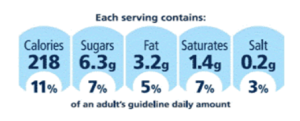
|
| Color-coded GDA/RI*2 FOPL systems *2 RI:Reference Intake |
It is a colour-coded GDA and a hybrid display system of GDA and TLL*3
*3 TLL:Traffic Light Labels |
United Kingdom: 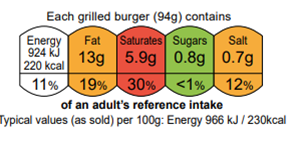 |
| Summary systems |
Displays the overall health index of the food product based on a calculated score. | Nutri-score 5 scores available- France 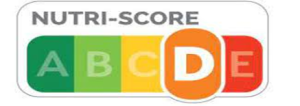 4 scores available-Singapore 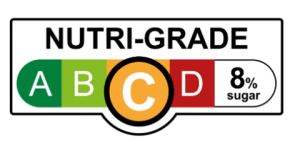 Health Star Rating 10 scores available-Australia 
|
| Endorsement systems |
Using logos/seals developed by nationally or internationally recognized organizations/institutions based on certain criteria to testify for the healthiness of the product |  Nordic Keyhole Nordic Keyhole(Scheme introduced by Swedish National Food Agency). It is used in Sweden, Norway, Denmark, Iceland, Lithuania and North Macedonia.*Please check the latest requirements to use the Nordic Keyhole. *Please check the latest requirements to use HCS. |
| Nutritional warnings systems | Using the following expressions “HIGH IN” or “EXCESS” referring to certain nutrients’ contents and specifically, sugars/fats (total, trans and saturated)/sodium, etc. The expressions that can be used vary from country to country and should be checked beforehand. | Latin America and Caribbean countries: Already enforced in some countries like Chile Mexico and Brazil, etc. and proposed for mandatory display in Canada. |
3.2. Updates and current situation
In Canada, as an additional step to ease and help consumers make healthier choices, FOP (front-of-package) labeling is being proposed by Health Canada to be displayed on specific food products that are high in sodium, sugars and saturated fat, along with other provisions and the expected changes are to be published this year.
This proposal comes aligning with other countries’ initiatives, without being a part of a formal regulatory cooperation plan with other international organizations. Health Canada is expecting compliance with these amendments to be by January 2026.
In the European region, the UK was the first country to implement it and published its guidelines in 2013 to help/encourage food business operators in developing the FOP labeling for their pre-packaged food products.
On UK’s Colour-coded GDA, it is also possible to add descriptive words along with the colours to reinforce the meaning: e.g. red/ “High”, amber/ “Medium” or green/ “Low”. This must be done in a clear and comprehensive way not to mislead consumers. It has already been adopted by the majority of food products in the British market.
Subsequently, the WHO launched calls for FOP labeling implementation as a part of their Food and Nutrition Action Plan 2015-2020. In 2017, France introduced its voluntary display said ‘Nutri-score’ FOP labeling, received lots of encouragement from WHO and EU and then adopted by other European countries.
3.3 The Nutri-Score label and EFSA*’s latest opinion
* EFSA: European Food Safety Authority
The Nutri-Score label was created based on Food Standards Agency (UK) nutrient profiling system (FSAm-NPS) score and is 5 colours and letters coded, from Green (grade A) to Red (grade E), indicating the healthiness degree of the product, in order to improve the consumers’ choice and encourage food operators to opt for healthier formulations.
The score calculations are made per 100g or 100ml and take into account both the nutrients to limit (calories, saturated fat, sugars and salt) and other elements (fiber, protein, nuts, fruits and vegetables, etc.). Later on, the European Commission has proposed the enforcement of such labeling on food products.
However, questions are starting to rise recently in regards to the efficacy of such a system.
According to the EFSA’s latest scientific opinion:
“A diet in line with science-based recommendations for food and nutrient intake is an important determinant of health. Because diets are composed of multiple foods, overall dietary balance may be achieved through complementation of foods with different nutrient profiles so that it is not necessary for individual foods to match the nutrient profile of a nutritionally adequate diet.”
This means that analyzing the nutritional value of a single food product cannot validate the healthiness of a whole diet. This study was previously preceded by the Italian Federalimentare, unsatisfied with the Nutri-score judgemental system, said to be ‘misleading’, by classifying most traditional products (e.g.: olive oil, parmesan, cured meat, etc.) as ‘unhealthy’ based on their fat/salt/sugars contents, etc, rather than their nutritional value and importance for health.
The constantly ongoing changes are mostly related to three main elements of a food label: ingredients list, nutrition facts and nutrition claims, based on scientific studies and consumers’ needs, to enhance the food safety and quality. The main motivators for governments are health and sincerity, to avoid misleading consumers into an unhealthy diet/lifestyle and to push food operators to make more efforts to refine their products.
We highly advise you to keep checking the latest updates every time for each country.
References
- Food labelling changes (Canada)
- The guideline for Nutrition Facts labeling based on Food Labeling Act for business operators (Japan)
- Carbohydrate and sugars claims (Canada)
- GDA label (UK)
- Guide to creating a front of pack (FOP) nutrition label for pre-packed products sold through retail outlets (UK)
- The Nutri-Score: A Science-Based Front-of-Pack Nutrition Label (France and other countries introducing Nutri-score)
- Measures for Nutri-Grade Beverages (Singapore)
- How to use Health Star Ratings (Australia)
- Front-of-package labelling (Latin America and the Caribbean, etc.)
- Experiences in the design and implementation of front-of-pack nutrition warning labels in Latin America and the Caribbean (Latin America and the Caribbean, etc.)
- Forward Regulatory Plan 2022-2024: Regulations Amending Certain Regulations Made Under the Food and Drugs Act (Nutrition Symbols, Other Labelling Provisions, Partially Hydrogenated Oils and Vitamin D) (Canada)
- Scientific advice related to nutrient profiling for the development of harmonised mandatory front-of-pack nutrition labelling and the setting of nutrient profiles for restricting nutrition and health claims on foods (EFSA)
Newsletter Signup
We issue monthly e-newsletters, which provide you with the latest updates on food labeling/regulations in Japan.
If you want to make sure to not miss any issue, please click below.
Related Service
Research Services on Ingredients & Food Labeling -For the Japanese Market-
We verify the conformity of ingredients and additives with the standards for use in Japan based on specifications such as formulation lists. We also verify the conformity of the proposed labeling of ingredient names, nutrients, etc. with the labeling standards based on specifications such as formulation lists.

Label bank Co., Ltd. Regulatory inspections and Consulting Research staff
Born in Tunisia. Specializing in bioengineering, her job mainly involves research work on foreign ingredients and additives, as well as monitoring information on amendments to food standards and labeling standards in various countries.
[Lectures/Seminars]
- “Regarding the Food and Beverages market in Japan: Food Standards, Additives, and Labelling criteria” (Kansai Food & Beverage Forum 2024: CCI France Japon/Kyoto) Sep. 2024
- “Regarding the Confectionary market in Japan: food standards, additives, and labelling criteria” (ISM Japan 2024/Tokyo) Apr. 2024

